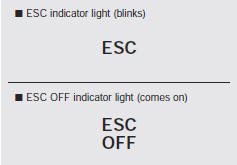Electronic stability control

The Electronic Stability Control (ESC) monitors information from various vehicle sensors and then compares the driver's commands with the actual behavior of the vehicle.
If an unstable condition occurs - a sudden evasive movement for example - ESC intervenes within fractions of a second via the engine computer and brake system and attempts to stabilize the vehicle.
ESC operation
ESC ON condition
• When the ignition is turned
ON, ESC and ESC OFF
indicator lights illuminate
for approximately 3 seconds,
then ESC is turned
on.
• Press the ESC OFF button for at least half a second after turning the ignition ON to turn ESC off.
(ESC OFF indicator will
illuminate). To turn the
ESC on, press the ESC
OFF button (ESC OFF
indicator light will go off).
• When starting the engine,
you may hear a slight ticking
sound. This is the ESC
performing an automatic
system self-check and
does not indicate a problem.
When operating
When the ESC is in operation,
ESC indicator light
blinks.
• When the Electronic
Stability Control is operating
properly, you can feel a
slight pulsation in the vehicle.
This is only the effect
of brake control and indicates
nothing unusual.
• When moving out of the
mud or slippery road,
pressing the accelerator
pedal may not cause the
engine rpm (revolutions
per minute) to increase.
ESC operation off
ESC OFF state
• To cancel ESC operation,
press the ESC OFF button
(ESC OFF indicator light
illuminates).
• If the ignition switch is
turned to LOCK position
when ESC is off, ESC
remains off. Upon restarting
the engine, the ESC
will automatically turn on
again.

Indicator light
When ignition switch is turned to ON,
the indicator light illuminates, then
goes off if ESC system is operating
normally.
The ESC indicator light blinks whenever ESC is operating.
ESC OFF indicator light comes on when either the ESC is turned off with the button, or ESC malfunctions when turned on.
WARNING - ESC
The Electronic Stability Control
system is only a driving aid; use
precautions for safe driving by
slowing down on curved, snowy,
or icy roads. Don’t attempt to
accelerate excessively just
because the ESC indicator light
is blinking.
ESC OFF usage
When driving
• It’s a good idea to keep the ESC
turned on for daily driving whenever
possible.
• To turn ESC off while driving, press the ESC OFF button while driving on a flat road surface.
Never press ESC OFF button while ESC is operating (ESC indicator light blinks).
If ESC is turned off while ESC is operating, the vehicle may slip out of control.
NOTICE
• When measuring the vehicle speed
with a chassis dynamo-meter,
make sure the ESC is turned off
(ESC OFF light illuminated). If
the ESC is left on, it may prevent
the vehicle speed from increasing,
and cause a false diagnosis of a
faulty speedometer.
• Turning the ESC off does not affect ABS or brake system operation.
WARNING - ESC
Never press the ESC OFF button
while ESC is operating.
If the ESC is turned off while ESC is operating, the vehicle may slip out of control.
To turn ESC off while driving, press the ESC OFF button while driving on a flat road surface.
See also:
Overview
Kia Motors America (KMA) announced the official North American debut of the
all-new Kia Sorento crossover utility vehicle (CUV) during a press conference at
the 2009 Los Angeles Auto Show. The fir ...
Power steering
Checking the power steering
fluid level
With the vehicle on level ground,
check the fluid level in the power
steering reservoir periodically. The
fluid should be between MAX and
MIN marks on t ...
Hazard warning flasher
The hazard warning flasher causes the
rear tail lights and front turn signal lights
to flash on and off, which serves as a
warning to other drivers to exercise caution
when approaching or passin ...


